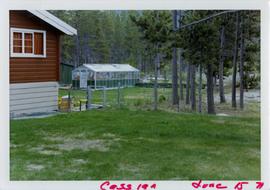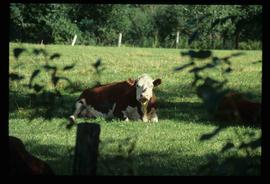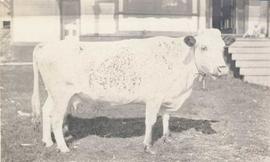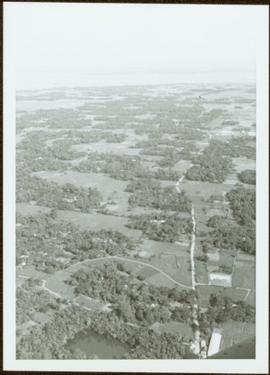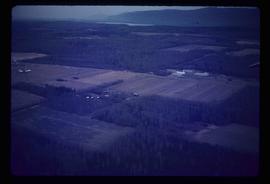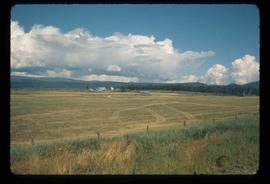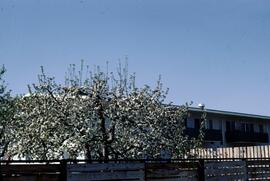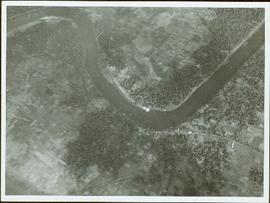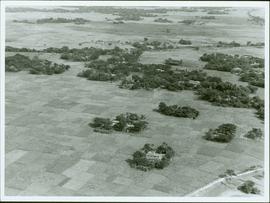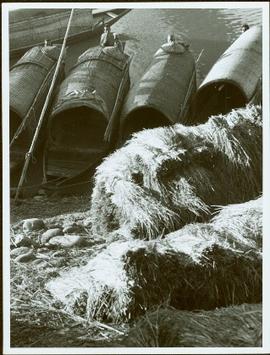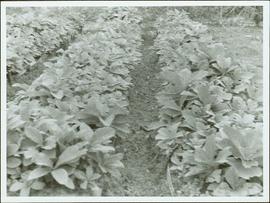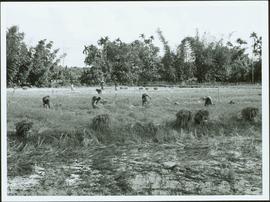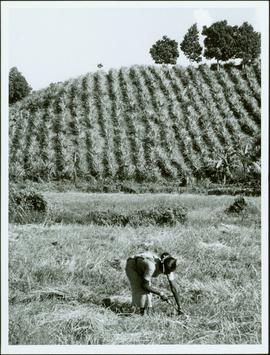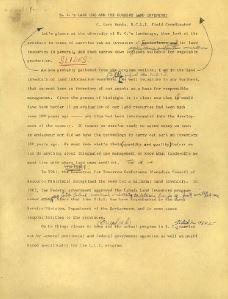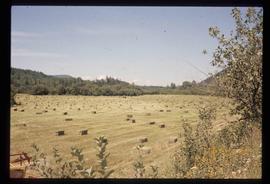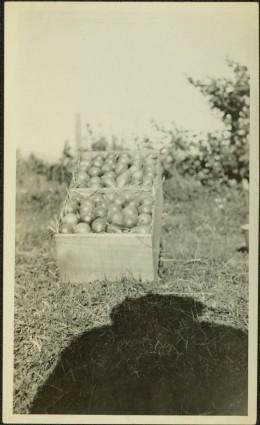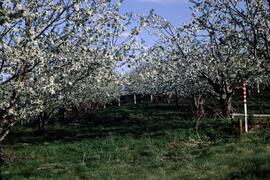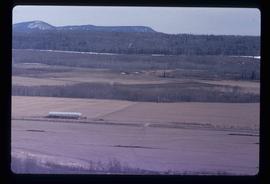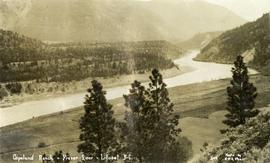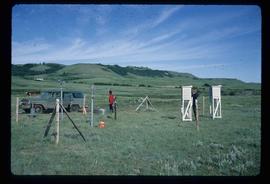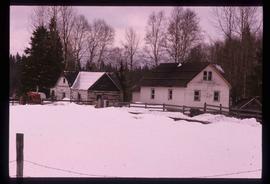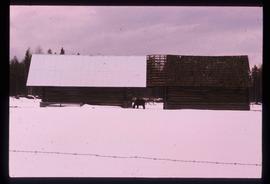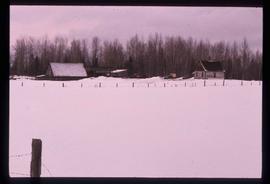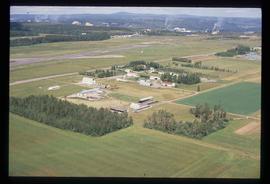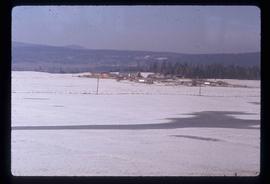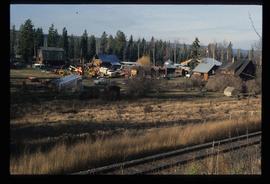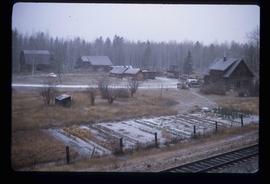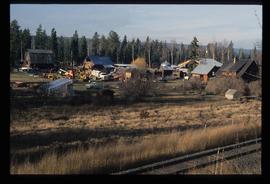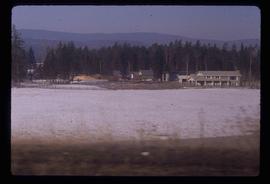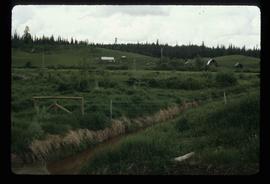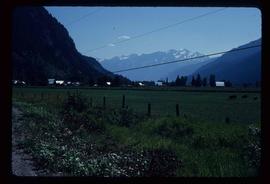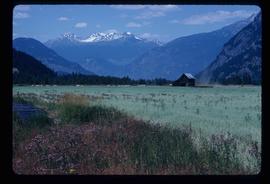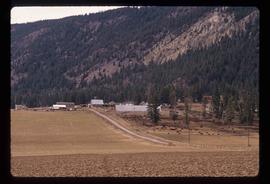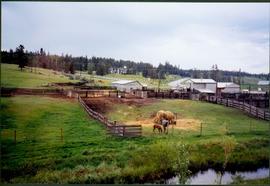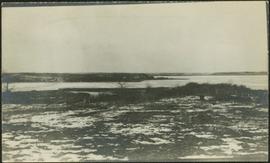Photograph depicts part of a brown and white building similar to the "Director's Lodge" at Cassiar, B.C. (see items 2000.1.1.3.19.88 and 2000.1.1.3.19.89). Unidentified individuals visible inside greenhouse in fenced back yard. Forest in background. Handwritten annotation on verso of photograph: "Cassiar June 15 71".
Image depicts a cow at an uncertain location.
Photograph depicts a cow with a bell around its neck standing in the front yard of a house.
File consists of a speech given by Gary Runka entitled "Action Steps to Sustainable Agriculture" at the Forum on Sustainable Agriculture in Summerland.
Commentary on this speech by Barry Smith of the Ministry of Agriculture and Lands:
"This speech opens with a relatively broad discussion of sustainability- how defined - and how this relates to agriculture. "We've got to develop the ability to view farming in a conceptual sense, to view food production sustainability over the full horizon, including the urban world, as well as farm field."
The speech is broken into 3 sections with sub-sections:
(1) From a Practical Management Point of View. What Does "Sustainability" Mean on the Farm, Orchard or Ranch? Several points are made including the protection of land through the ALR. The principles of sustainability in, "Towards a Strategy for Sustainability" are listed.
(2) From the Food Producers Perspective, What are the Gaps in Practical Requirements to move Toward Sustainability? The points identified in the July 1994 workshop "Future of Agriculture in the Okanagan" are listed and noted as key points.
(3) With Land and Water Resources under Stress, What are the Action Steps to Regional Multicommodity Agricultural Sustainability? Under this topic seven sub-topics are explored:
a) sustainability and security of the land base with a particular emphasis on parcel size and the need for consolidation, land tenure, cost and speculation;
b) sustainability and water resources;
c) land use competition, compatibility, and planning process access - with an emphasis placed on the need for the farm community to have access to the planning process and a nod to the importance of Agricultural Advisory Committees. It is recognized that this will take an integrated effort of the ALC and Municipal Affairs;
d) vertically consistent policies and regulations from local to federal;
e) Right to Farm (with a plea to revisit the then current 'Agricultural Protection Act');
f) public education;
g) food policy; and
h) Socio-economic strategy for agriculture"
Item is a photograph of forests and farms from the air.
File consists of a speech given by Gary Runka entitled "Agricultural Land and Its Management".
Commentary by Barry Smith of the Ministry of Agriculture and Lands:
"This paper has no indication of the audience or date but given that there are several references to 1990 reports, it probably dates to 1991.
Although the scope of this paper is national in several aspects, its primary focus is on the B.C. farmland preservation efforts.
Comment is made on the question of farmland being regarded as a 'commodity' vs 'scarce resource'. GGR draws upon a theme found in other speeches and papers when he notes that 'To some degree, the call for a new "foodland ethic" is based upon the belief that public policy should more adequately take into account the social value of foodlands, quite apart from the dollar value...."
The paper is broken into several sections:
(A) The Setting;
(B) Agricultural Land Loss, (which includes some excellent statistics - p. 2-3)
(C) Some Agricultural Management Issues,
(D) Action Response (this section briefly reviews farmland preservation efforts in each province with a particular emphasis on B.C. p. 5-6),
(E) The Future.
GGR lists the following action steps that BC should pursue:
- Repeal ALC Act appeals to Cabinet;
- Rescind the outright golf course use within the ALR; and
- Introduce Soil Conservation Legislation"
File consists of a speech given by Gary Runka entitled "Agricultural Land and Land Use Decision Making in the 1980s" for the Western Land Directors' Conference, Victoria BC (June 7-11,1981).
Commentary on this speech by Barry Smith of the Ministry of Agriculture and Lands:
"The speech is a collection of familiar themes but GGR's assemblage and delivery is becoming ever-more refined. The speech was accompanied by overheads but they are not included.
The paper starts with two quotes from Hans Blumenfeld and O'Malley. In the case of Blumenfeld - North Americans want to live in efficient, convenient, healthy and pleasant environment but as individuals we want to be able to make an honest dollar out of every piece of property we own. The two concepts are basically incompatible. The O'Malley quote speaks of land as a mother because she gives life, is a provider, protector and comforter.
Some (but far from all) of the important observations include:
- integrated land use policy is slow in coming;
- issues have to be addressed at each level of government;
- for each use option and the resulting integrated policy framework must be established through appropriate legislation and regulation;
- we are all well aware, there are some use demands that by definition, exclude other use demands (agriculture is highlighted as a prime example);
- non-agricultural or urban demands vary according to location, as does the "resistance" of agriculture to the change.
- some private demand is purely speculative, especially in an inflationary period. During these times, the demand, particularly for irreversible uses of land, often greatly exceeds the real requirements for use;
- we have always been able to produce the "next frontier", why not now?
- understanding the land is the most important prerequisite to its wise and proper use;
- an integrative spirit and process is essential if sound planning is the target.
The paper ends with the following quote from Bill Moyers, "Government is the art of trying to solve problems. Politics is the art of trying to attain power. The two meet sometimes, but not often."
File consists of a speech given by Gary Runka entitled "Agricultural Land Commission 1978 - What's Happening?" to a UBC Soil Science and Land Use Planning Seminar.
Commentary on this speech by Barry Smith of the Ministry of Agriculture and Lands:
"This is simply a single page outline of a speech given at a UBC Soil Science and Land Use Seminar providing an overview of the farmland preservation program to date.
The outline is broken into 5 sections:
- Brief History (of the legislation, designation of the ALR and program administration);
- Fine Tuning (of the ALR);
- Grazing Lands;
- Settlement and Community Plans; and
- The "young farmer" program"
The actual speech based on this outline is not included."
File consists of a speech given by Gary Runka entitled "Agricultural Land Preservation - Some of the Problems" to an unknown audience, possibly a political caucus. A "Process Chart" of the B.C. Agricultural Land Commission Act is attached to the speech.
Commentary on this speech by Barry Smith of the Ministry of Agriculture and Lands:
"This speech was given several months after GGR's resignation as Chair of the Commission in January, 1979. There is no specific indication of who the speech was given to but mention is made to "caucus members" (p. 4) and therefore may have been the NDP caucus.
Specific mention is made to the opportunity to undermine the program by the Section 9(8) changes to the Act. (This is a reference to allowing the Minister of Agriculture to forward appeals of Commission's decisions to the Environment and Land Use Committee of Cabinet if no two Commissioners give leave to appeal)..
Mention is also made to the need for the Commission to be aware of problems affecting agriculture if it is to be the true defender of agricultural interests. Reference (p. 3) is made to the Commission being: "... too busy attending to applications to take a seriously positive role to ensure that present and future land use conflicts ... are minimized."
GGR also raises his concern with attempts to narrow the definition of "agricultural land" by suggestions that CLI Class 4 - 7 lands be automatically excluded from the ALR. He also expresses the need to be concerned with land use planning outside the ALR.
GGR criticizes "a less than positive attitude by government" (to farmland preservation) and calls for the need for a provincial land use strategy."
File consists of a speech given by Gary Runka to the B.C.I.A. entitled "Agricultural Land Reserves and the Land Commission Act".
Commentary on this speech by Barry Smith of the Ministry of Agriculture and Lands:
"With the original package associated with this speech are 5 pages of rough notes for another speech with the same title prepared for a B.C.I.A. meeting on March 22, 1976... Given that these rough notes were held with the material associated with the April 15, 1976 meeting it is possible the B.C.I.A. meeting planned for March was shifted to the April date. Additionally there are 6 pages numbered 6-11 that are of some detail concerning the work of the Commission but appear to be part of another speech but are included with the B.C.I.A. package and have, therefore, been [included with this speech].
The title of the speech "Agricultural Land Reserves and the Land Commission Act" sums up the thrust of the speech which notes the objectives of the legislation, the Commission's program of land acquisition and Commission research and support of innovative projects to assist rural planning to create a positive environment for agriculture and give direction to urban growth away from farmland.
Additionally an overview is provided of the Commission's activities in its first two years of operation. GGR comments that establishing the ALRs "... was but a first step and we feel that it is our job to continue to protect the Reserve by whatever approaches and methods of rural planning that are available to us". This speaks to a Commission that saw its role, even at this early stage, as being much more than simply a rationing board reviewing ALR applications.
Several examples are outlined in which it is suggested that professional agrologists should be looking at carefully.
At the end of the speech (p.5) GGR includes (a note to himself) to "follow with example of an agrologist's public statement" that obviously was of concern. The actual public statement was not included with the speech given on April 15th but was included in the rough notes of the speech dated March 22 which read as follows:
"Yet a member of the B.C.I.A. - a P.Ag - is quoted in the press in response to a local politician who asked him a question something like this in regard to an ALR exclusion application:
Local politician: What about the international, national and local concerns regarding land for future food production?
BOA member P.Ag: We should firstly be concerned with places for people to live and secondly worry about land for food production.
This is our profession - the image is yours to make.
I don't mean that we should go overboard, but if we are not willing to defend preservation of agricultural land - who is?"
Image depicts an agricultural field, most likely near Prince George, B.C.
File consists of a speech given by Gary Runka entitled "Agriculture in the Urban Shadow" at the Agricultural Land Commission Symposium - Urban Growth and the Agricultural Land Reserve: 'Up not Out' - March 9,1993.
Commentary on this speech by Barry Smith of the Ministry of Agriculture and Lands:
"This represents an important, highly pertinent speech concerning farmland preservation in B.C. The speech was given at the ALC Symposium marking the 20th anniversary of B.C.'s farmland preservation program. The speech rings as relevant today as it did when delivered 22 years ago.
It begins by identifying two perspectives - one, those committed to an agricultural future, contributing diversity and having a social value and two, those that feel agriculture is ultimately doomed and is only an interim use, especially in the urban shadow, until a "higher and better" use comes along. GGR states that we need to honestly state which perspective we are guided by.
There are a host of important themes woven through this paper including:
- While farming on the urban shadow benefits both the urban and farm communities, the negative impacts of urban/farm adjacency are predominantly borne by the agricultural community.
- In describing the situation prior to the farmland preservation legislation in the 1960's and early 1970's agriculture was consistently the "loser user".
- Even in the earliest days of the Commission, urban shadow issues were identified and the ALC recognized that provincial zoning was only a first step, and taken alone, was not enough.
- The BC farmland preservation program has been at least as successful as anywhere else in North American and looked on with envy in many other jurisdictions.
- GGR believes that after 20 years we are worse off today than when the program started due to (i) elected provincial politicians involved with the application process (ii) the ALR / Golf Course fiasco and (ill) the ALC has become paralyzed in their Appeal Board mode.
Several (13 starting on p. 7) urban shadow issues are outlined and GGR states that we must be serious about addressing urban shadow issues.
The paper ends with an outline of "where we need to be tomorrow" and GGR states: "I recall when the program began in 1973 we argued that all of the compromises with respect to agriculture had already been made, if we were to keep the options open for future
generations In British Columbia. If that statement was true then, how much more true is it today, 20 years later?"
From the Symposium concluding remarks, Gary Runka stated that based on his experience and discussions during the symposium, he believed that the following initiatives should be given priority:
- Information and education programs
- Communication between farmers, government and the public
- Regional land use planning
- Integration of government policies to a strong farmland preservation strategy
- Provincial agricultural strategy
- Programs which insure farms can be viable
The Symposium proceedings have been compiled in a 67 page ALC publication."
Image depicts some farmland near Alexandria, B.C.
Slide depicts an apple tree blossoming in a backyard. The yard is surrounded by a wooden fence. Original slide index description: "Apple blossoms Kelowna."
File consists of an article written by Gary Runka entitled "Balanced Agriculture - Its Social Value" for the Symposium o n Decoupling, Ottawa - February 10-12,1988.
Commentary on this speech by Barry Smith of the Ministry of Agriculture and Lands:
"This speech was prepared for publication in the July 1988 edition of t he "Canadian Journal of Agricultural Economics".
The Symposium explores the social and economic values of agriculture and this paper primarily pursues the social value side of the equation and asserts that a healthy agricultural sector has a social as well as economic value to Canada.
The paper is broken into four sections:
(I) The Farm;
(II) Rural Communities and Regions;
(III) Canada and Beyond; and
(IV) Summary.
Under these broad topics the paper considers several themes, many of which have a strong or direct relationship to farmland preservation. B.C. and Quebec programs are directly mentioned. A few of these themes are captured here:
- "balanced agriculture" ... let it imply a balance between economic considerations (market forces) and social values
- It is not easy to design legislative programs that will accommodate both the legitimate financial concerns of those who husband the land and the desire of society to protect a scarce resource
- Society must share in t he responsibility to retain foodlands. "...both Quebec and British Columbia accepted this responsibility in their agricultural land preservation legislation by bring in associated commodity income insurance programs along with the provincial designation of land within agricultural land reserve zoning."
- A need for balance between private rights of land ownership with stewardship and the responsibility of government to intervene when private interests do not coincide with public interests.
- The urban majority will have a growing influence on the way farmers and agriculture will be treated in coming decades
- Any country is wise to ensure that it retains the option to produce at least a portion of its own food
- Do we want agriculture driven by a "trade environment" or do we as a country have other social goals that we wish to pursue, of which international trade is part?
- It is in Canadian society's general interest to have economic and social cohesion when considering agricultural policy reform."
Item is a photograph of a river bend and the surrounding country taken from the air.
Item is a photograph of a rural area taken from the air.
Item is a photograph of boats docked on the shore behind piles of grain or straw.
Item is a photograph of rows of plants in a garden.
Item is a photograph of people harvesting grain by hand.
Item is a photograph of a woman working in a field.
File consists of a speech given by Gary Runka entitled "BC Experience: Establishing Priorities for the Use of Rural Land Resources" for the Canadian Institute of Planners Annual Conference in Kitchener, Waterloo.
Commentary on this speech by Barry Smith of the Ministry of Agriculture and Lands:
"This is a second speech GGR gave at the 1980 CIP Conference.
The 'rural' stage is set by stating that BC is 94% crown land of which 53% is unreserved crown land - so lots of rural land to plan for.
The paper largely outlines 8 examples of rural land use priorities in BC including:
- Integrating rural land use policy under the Environment and Land Use Act
- Agricultural Land Commission Act protecting farmland
- Forest and Range Act
- Municipal and Regional government community, settlement and regional plans - largely on non-crown land
- The Federal government's amended Fisheries Act
- Special Statutes Planning - The Islands Trust Act
- Crown land Planning Strategies
- Environment Planning via an Environment Act, Water Basin Plan and Wildlife along with complimentary legislation.
The paper helps to place the farmland preservation in the context with other land use planning efforts in British Columbia."
File consists of a speech given by Gary Runka entitled "BC Land Use Issues and Smiling Frogs" for the Agricultural Institute of Canada Foundation.
Commentary on this speech by Barry Smith of the Ministry of Agriculture and Lands:
"This presentation, which was accompanied by slides (not with speaking notes) reviews five diverse land use issues of which three involve agriculture, two of which were directly linked to the ALC.
The 'Smiling Frogs' metaphor is wonderfully explained as the heat is turned up and down on land use issues and complacency is something to be avoided.
GGR was directly involved in some capacity with each of the issues reviewed and, therefore is in a position to provide an "insiders" point of view. The five issues were:
- Burnaby Business Park (Burnaby Big Bend) - Lower Mainland - a very succinct overview is provided for this win-win accomplishment which directly involved ALC decision-making.
- Charlotte-Alplands (West Chilcotin) - involved an exploration of forest, recreation and wilderness tourism opportunities and the identification of potential conflicts.
- Fraser River Delta (Delta Farmland and Wildlife Trust) - considers the successful coming together of agricultural and wildlife interests in an area that has both internationally significant wildlife habitat and an important part of the Pacific Flyway but also comprises one of the best agricultural areas in Canada.
- Mid-Coast (Greenpeace and Western Forest Products) - provides insights into a very hot issue that had some success and some failure in trying to get two very opposed sides together in which the Land and Coastal Resource Management Planning process is struggling.
- Six Mile Ranch (Kamloops) - every so often the ALC is faced with what might be referred to as an application of province wide notoriety and Six Mile Ranch assuredly fit this description. The application involved a proposal in the Kamloops area (but some distance from Kamloops) to use an area of interior grasslands ALR for urban development in the form of residential, resort and golf course. GGR sums up his feelings nicely on this land issue - "My involvement in this fiasco is indirect and that of "Citizen Runka" and perhaps more specifically as a student of government stupidity."
File consists of a speech given by Gary Runka entitled "BC Soil Conservation Issues: How Serious are They?" for a BCFA Soil Conservatiori Seminar - March 10,1987.
Commentary on this speech by Barry Smith of the Ministry of Agriculture and Lands:
"Stressing the importance of soil conservation, this speech begins by noting that all land and water users (not just agriculture) - on-site or off-site - are involved with soil conservation.
The paper is broken into 3 sections:
(1) Framework Considerations in which the diversity of BC's landform and climate is noted. The key soil conservation issues from a provincial perspective are reviewed including:
- erosion;
- sedimentation;
- acidification;
- organic matter loss; and
- soil compaction.
(2) Economic Considerations - the estimated loss annually in agriculture due to soil erosion is 30 to 50 million dollars.
(3) Legislation and Institutional Structure Considerations - BC is noted as having no provincial legislation that has soil conservation as its main thrust.
While the ALC Act and ALR are not directly mentioned, soil conservation is an important associated issue related to farmland preservation."
File consists of a speech given by Gary Runka entitled "BC's Agricultural Land Reserve - Its Historical Roots" at the Post World Planners Congress Seminar.
Commentary on this speech by Barry Smith of the Ministry of Agriculture and Lands:
"Vancouver hosted the World Planners Congress in June 2006 and the day following the Congress the BC Ministry of Agriculture and Lands and Agriculture and Agri-Food Canada hosted a full day seminar entitled "Planning for Food".
GGR provided an important overview of the BC farmland preservation program. The speech begins with comments outlining the factors motivating the government of the day to enact legislation to preserve agricultural land. The presentation was then broken into three time periods including:
The Formative Years (1972-1975)
The Refinement Years (1976-1996)
The Uncertain Years (1996-????)
GGR in his summary poses some less than optimistic questions and observations. He states that despite successes "there are growing
concerns that, over its history, the focus of the program has subtly shifted - from an agency devoted to farmland preservation, to a rationing board." He sees the focus on application review as being detrimental to the Commission's role of promoting and encouraging farming in the ALR. Given this shift in direction he presents several suggestions to get the program back on track.
The presentation ends with a challenge to the people of B.C. to decide whether the next segment of the B.C. farmland preservation history is entitled 'The Rebuilding Years' or not."
File consists of a speech given by Gary Runka entitled "BC's Land Use and the Current Land Inventory".
Commentary on this speech by Barry Smith of the Ministry of Agriculture and Lands:
"Although page 4 of this speech is missing (or possibly intentionally deleted), this document provides a detailed explanation of the CLI ratings and may well have been the basis of interpretation guidelines for agricultural capability mapping used by the ALC.
GGR at the time was the B.C. Land Inventory Field Coordinator.
It appears that slides at one point accompanied this speech."
Image depicts a field of hay somewhere in Beaver Valley.
Photograph features a wooden box of pears sitting on grass, bushes in background. Handwritten annotation on recto of photograph: "This is a prize box of pears." It is believed that this photograph was given to Lillian & A.K. Bourchier by their niece Jean.
Slide depicts cherry trees blossoming in an orchard. Original slide index description: "Cherry blossoms Lakeview Heights."
Image depicts a view of some farm land in Chetwynd, B.C.
File consists of a speech given by Gary Runka entitled "Consensus Decision Making" for an Executive Development Program.
Photograph depicts the Copeland ranch on a bench of the Fraser River in Lillooet, BC.
Image depicts two unidentified individuals and a van on a farm at an uncertain location, possibly a place called Cypress Hill, with an atmometer and a sunshine recorder.
Image depicts a farmhouse in Dome Creek, B.C.
Image depicts a horse and a barn in Dome Creek, B.C.
Image depicts a small farm located in Dome Creek, B.C.
File consists of a speech given by Gary Runka entitled "Effects of Urban Decision Making on Rural Issues".
Commentary on this speech by Barry Smith of the Ministry of Agriculture and Lands:
"The introduction begins by stating that urban-oriented people are making decisions that impact on rural issues and land / people relationships. This paper provides a perspective largely from a rural point of view although, at the very end it is concluded that people in rural areas are often unaware of the dynamics of urban needs and priorities.
While the examples of urban influences on rural areas are too numerous to comprehensively outline even in a 16 page speech, GGR does cover a lot of ground in this regard in the paper. He feels that through careful planning built on understanding we can, as a society, achieve a comfortable balance.
The question is asked, who is rural and who is urban - there is a degree of blurring. The paper considers urban decision-making in the broadest context - whether political, economic or social.
The paper is broken into a consideration of urban decision making and its effects on rural areas from a number of points of view - (1) Political; (2) Economic; and (3) Lifestyle.
It is noted that there is a need for greater understanding of agriculture from both a rural and urban point of view and the spin-offs of food and fibre production in providing jobs in the urban community is not widely recognized by urban citizens or elected officials.
As the number of urbanites take up residence in rural areas their power at the local ballot box also increases. Three examples of urban decision making on rural issues are explored including:
(1) The "Killer" Mall;
(2) The "Suburban" Horse; and
(3) Soil Conservation.
Interdependence is specifically emphasized - there is seldom any decision taken that does not impact to some degree somewhere else along the urban-rural continuum."
File consists of a speech given by Gary Runka entitled "Expanding Needs from a Finite Resource: the Necessity for Sound Land Use Planning" for the Manitoba Land Use Conference Land User for the 80's - Private Rights and Public Interests, March 11 & 12,1981.
Commentary on this speech by Barry Smith of the Ministry of Agriculture and Lands:
"The conference theme of "Private Rights and Public Interests" is one that GGR often turned to. In this fairly lengthy speech GGR pulls together, in one paper, many of the themes and positions he has turned to in other speeches. He explains the 'land and water maze' and lists 12 uses competing for limited land and water resources. It is noted that the imbalance between agriculture vs urban uses, due to urban uses commanding much higher values resulting in agriculture finding itself in a defensive position, is discussed.
As the conference theme enunciates - GGR explores the tug-of-war between the myth of limitless land and community needs vs property rights and the fallacy that individual land use decisions do not impact the larger community. GGR emphasises the slowness of changing attitudes and the even slower political response and policy change. The confusion of jurisdiction concerning what level of government is best positioned to deal with resources issues is considered. GGR emphasizes the need to plan the use of land resources in an integrated and comprehensive fashion and the need for shared decision making.
Policy 3 of Manitoba's Regulation #217/80 - "Rural residential development should not be thought of, nor normally planned, as an evolutionary step from a rural landscape to an urban development" is noted. It is emphasized that the planning process has to catch up with the rural reality.
Central message - the importance of planning land and water use must be in keeping with the natural characteristics of the land and the needs and values of the local community. This latter point is of interest from the point of view that local community values and plans may dash with provincial values or policy."
Image depicts a view of an experimental farm, possibly taken from Tabor Mountain.
Image depicts a farm at an uncertain location.
Image depicts a farm likely in Woodpecker, B.C.
Image depicts a farm likely in Woodpecker, B.C.
Image depicts a farm likely in Woodpecker, B.C.
Image depicts what appears to be a farm at an uncertain location.
Image depicts a farm at an uncertain location; possibly somewhere in the McGregor Valley.
Image depicts a farm at an uncertain location.
Image depicts a farm at an uncertain location.
Image depicts a farm at an unknown location.
Photograph depicts two horses in one of many fenced areas, buildings and machinery in background. Highway, house, and forest also visible in distance.
Photograph depicts snowy area speculated to be a farm yard in foreground. Frozen water crosses midground, opposite shore in distance.
